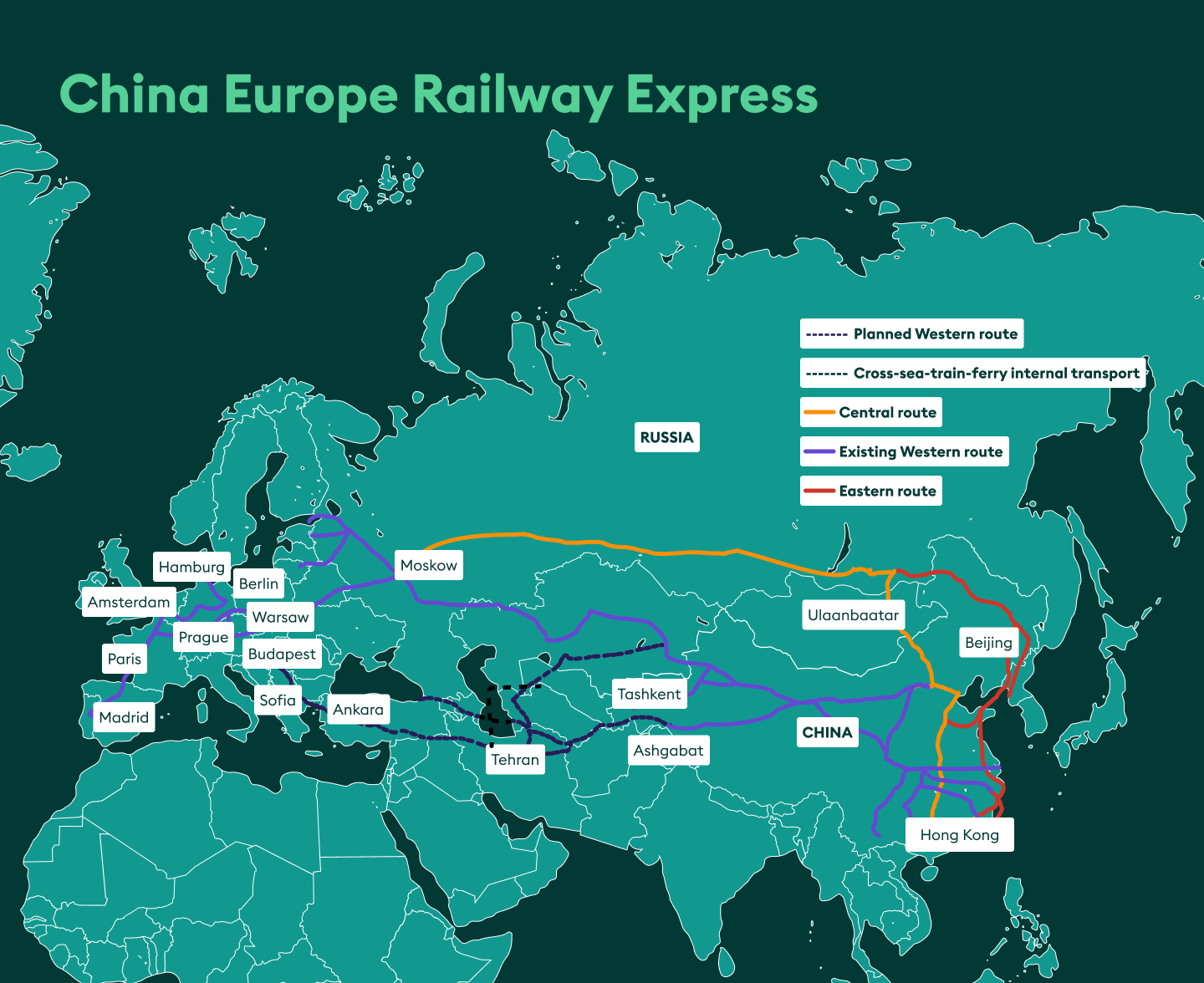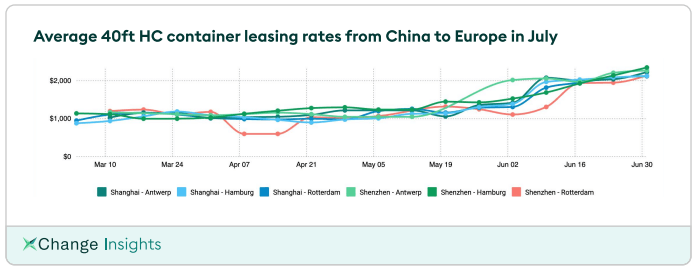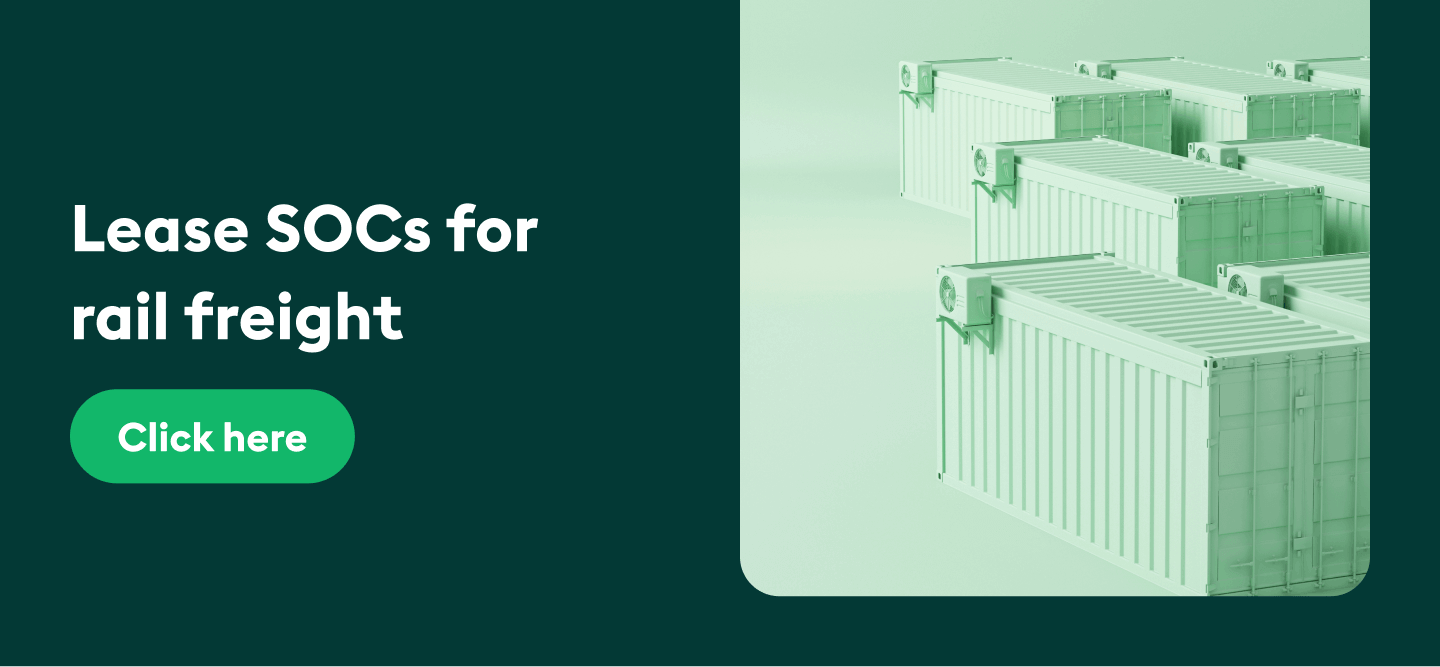The China Europe Railway Express (CRE) connects China and Europe through an extensive network of rail services. Read this blog to find out about the CRE, its benefits, as well as the challenges it faces. We’ll also help you source containers at budget-friendly rates.
In 2023, 1.9 million TEUs were shipped along the China-Europe Railway Express. The China National Railway attributes this increase in traffic to several initiatives implemented along the route in recent years.
Using the CRE has many benefits, including faster delivery times and simpler customs procedures. However, if you’re planning to move cargo from China to the USA, you may have come up against a few challenges, such as sourcing units at budget-friendly rates, and finding suppliers you can trust.
If you want to secure containers at the best leasing rates, we recommend connecting with suppliers who are willing to reposition their empty units without any additional charges. It’s a win-win situation: you move your cargo at a good price, and they avoid empty container repositioning.
Using Container xChange is your all-in-one solution. We’re the largest global container marketplace with 1,700+ vetted partners to work with, in 2,500+ locations. You can connect directly with suppliers to negotiate the rates you’re comfortable with—no middleman or commission involved!
Try our public search to browse and compare leasing offers along the stretch of your choice today.
25 x 40HC
Container Supplier
Container Company Blurred Name
5
Pick-up charge
User pays
$120
19 Freedays
$44.20 Per diem
What is the China Europe Railway Express?
The China-Europe Railway Express, or China Railway Express (CRE), is a network of international multimodal container rail services that connect cities in China with cities in Europe.
The CRE is part of China’s Belt and Road initiative, and provides overland transportation for cargo, bypassing the traditional maritime routes that connect these two regions.
Chen Fengying, a researcher at the China Institutes of Contemporary International Relations says, “The China-Europe freight train service has, to a certain extent, ensured the security and stability of industrial and supply chains.”
We’ll learn more about the benefits of the China-Europe Railway Express in the next section.
What makes the China-Europe Railway Express a top alternative to ocean freight shipping?
The CRE offers a reliable alternative to traditional container shipping. It facilitates the transportation of a diverse range of Chinese goods to European consumers, including household appliances, car parts, and clothing. Let’s dig deeper!
Faster transit times
While shipping cargo via ocean typically takes between 30 and 45 days, the CRE is significantly faster, at only 15 to 20 days. This is particularly important in industries where the swift delivery of goods and resources is crucial for profit.
Reliability and stability
The China Railway Express is far less affected by harsh weather conditions than ocean freight. While delivery of ocean freight is often delayed by storms and port congestion, rail freight tends to be more reliable.
Flexibility
CRE supports intermodal activity, meaning that containers can easily be moved between rail, road, and even sea. This makes it easier to reach inland destinations in Europe that are not directly accessible via the ocean.
It’s important to note that although the CRE has many benefits, it is more expensive than sea freight. So if time is on your side, opting for ocean transport is the more budget-friendly option.
Here are some of the most popular rail routes from China to Europe.
Popular shipping routes from China to Europe
The China-Europe Railway Express operates along three major corridors: the eastern, central, and western routes.
The eastern route primarily serves Chinese exports from coastal regions, notably Yiwu in the eastern Zhejiang province. It exits China through Manzhouli in Inner Mongolia, traverses Russia, and enters Europe via Belarus and Poland.
The central route is dedicated to goods produced in central China and southern coastal provinces like Guangdong, a manufacturing hub. It enters Mongolia through Erenhot in Inner Mongolia, crosses Russia, and then reaches eastern and western Europe.
The western route primarily facilitates exports from western China entering Kazakhstan via Alashankou or Khorgos in the Xinjiang Uygur Autonomous Region. From there, it extends further into Europe. Most of these routes pass through Russia, Belarus, and Poland, with a few trains also transiting through Ukraine en route to Hungary.
China Europe Railway Express map
From the map below, we can see that the China-Europe railway does not travel along a single route. Rather, it is a network of railways that spans the two continents.
CRE trains currently run along 73 routes, connecting more than 50 cities in Mainland China with 217 cities in 25 European countries.

If you’re struggling to find containers at good leasing rates along one or more of the China Europe Railway Express routes, we’ve got you covered.
On Container xChange, you can find containers for one-way moves in just a few basic steps, and negotiate a rate that fits your budget. Connect with 1,700+ reputable companies to settle on a leasing deal that suits you right now!
Challenges ahead for the China-Europe Railway Express route
A major concern with the CRE is its susceptibility to geopolitical risks. With a rail network passing through multiple countries, the CRE’s strength during peacetime becomes a potential vulnerability during times of war or political instability.
Disputes between nations or trade partners can disrupt the smooth flow of goods, affecting the reliability of this crucial trade link.
Let’s take a deeper look at how this happens below.
Impact of the Russia-Ukraine war on China’s Silk Road project
The Russia-Ukraine war has reshaped the dynamics of the China-Europe Railway Express. In response to the geopolitical risks associated with the northern rail route through Russia, the Middle Corridor has gained prominence.
Traders who were hesitant to send goods through Russia have now shifted to the Middle Corridor, which bypasses Russia.
This Middle Corridor not only offers a safer pathway for goods but also access to Mediterranean ports. The transition holds significance for Ukraine’s post-war recovery, as the country can receive essential rail-dependent commodities from Central Asia and China without relying on Russia.
While the Middle Corridor presents a promising alternative, it may not fully replace the convenience of Russia’s rail network due to its complexity and additional border crossings. Nonetheless, it stands as a significant response to the growing demand for secure trade routes.
Impact of the Red Sea attacks on leasing rates along the CRE
With the Red Sea crisis continuing to disrupt global supply chains, we’ve witnessed a reduction in available capacity on both the Asia-Europe and trans-Pacific routes.
Carriers are struggling to meet the demand due to unusually heavy shipping volumes, longer voyages around southern Africa, and congestion in major Asian ports.
As a result, the current shift from congested ocean routes to the China-Europe rail network is leading to significant delays along the China-Kazakhstan border. This in turn has resulted in longer transit times and a rapid increase in freight rates.
From the graph below, we can see that the average leasing rate for a 40ft HC container from China to Europe increased from US $1,463 in June 2024 to US $2,223 at the start of July 2024. This marks a 51% increase in just a single month.

Apart from the geopolitical challenges, the CRE also faces another major challenge, which is empty container repositioning. Read on to find out more.
Avoid empty container repositioning with the China Europe Railway Express
Another major setback when it comes to transporting cargo from China to Europe is the risk of empty container repositioning.
The China Europe Railway Express is predominantly used for westbound Chinese exports, with empty trains often returning to China. There’s a huge difference in the westbound and eastbound volume: 80% of eastbound containers are empty, while 89% of westbound containers are fully loaded. This disrupts the container flow.
Container imbalances of this nature can reduce your profit margins significantly when you’re transporting cargo on this route.
Consider this: A shoe company in China is exporting from China to Europe. Once the goods arrive in Europe, the cargo is discharged. The company then realizes that there isn’t enough cargo to import back to China.
This is when these empty containers start to pile up. Imports exceed exports, leading to a surplus of containers in Europe. This means that China doesn’t have enough goods coming back—leading to a deficit of containers.
The cost of moving the empty containers can be more than the value of the container itself! So how do you move your rail freight without incurring empty repositioning costs? By leasing SOCs (Shipper-Owned Containers) for one-way moves on Container xChange. Read on to find out more.
How much does it cost to lease SOCs?
A container is considered SOC when the Beneficial Cargo Owner (BCO), freight forwarder, or NVOCC organizes its own container.
These containers offer more flexibility compared to COCs (Carrier Owned Containers). In multimodal transportation, you move your containers by rail and transport them via road to reach the final destination. Using SOC (Shipper Owned Containers) offers flexibility in this process.
You don’t have to worry about returning the containers once they arrive at their destination. You simply lease containers for one-way journeys to move your goods, and that’s the end of the story. You get to move your cargo while the container owner gets to move their containers.
Curious about how much it will cost you to lease SOCs one-way with us? Have a look at the average pick-up rates from China to Europe for standard containers on our platform below:
- 20ft container pick-up charges from Shanghai to Aarhus are US $620
- 40ft container pick-up charges from Qingdao to Rotterdam are US $283
- 40ft HC container pick-up charges from Shanghai to Aarhus are US $1,468
Now let’s take a look at how xChange can help you secure SOCs at the best rates with our easy-to-use leasing platform.
Lease SOCs on the China Railway Express route and save big with Container xChange
Ready to save on costs and avoid empty container repositioning with us? Here are the quick and easy steps to leasing SOCs for your shipments on our platform.
Browse and compare leasing offers
First things first, hop onto the xChange leasing platform to start browsing available offers on SOCs. Here you’ll be able to see the pick-up charges, per diem charges, and free days. You can also check out the public profile of any company on our platform before deciding who to work with.
Reach out to suppliers directly
Once an offer catches your eye, reach out to the company directly to negotiate the rates and settle on the final details of the offer. On our platform, there are no middlemen, so you don’t have to worry about commissions hiking up the final price.
Pay safely on the platform
Once the deal is finalized, you can make payments directly on xChange through our secure payment feature. All transactions are encrypted for an added layer of security.
Here’s what Neptune Global Logistics, a rail and shipping freight forwarder in Shenzhen, China, has to say about using xChange to avoid hefty empty container repositioning charges:
“We found a way around China’s one-way container shortage with xChange. Since joining, we’ve made 39+ reliable partners overseas and have successfully repositioned 1000s of our empty containers.”
If you too have empty containers that need to be repositioned, or you’re looking for SOCs to move cargo one-way at budget-friendly rates, our team is here to help you on this journey. Click the banner below to chat with one of our experts today, and you’ll be saving money for your business in no time at all.
Common FAQs: China Europe Railway Express
Is there rail freight between China and Europe?
Yes, the China Europe Railway Express is a network of rail services that connects cities in China with cities in Europe. It provides an overland transportation route for cargo.
How does China ship to Europe?
The traditional maritime route between China and Europe runs through the South China Sea, the Malacca Strait, the waters of the Indian Ocean and the Suez Canal. The China Europe Railway Express also connects both the continents through an extensive railway network.
How many routes are there on China Europe Railway Express?
The China-Europe Railway Express (CRE) operates along three major corridors: the eastern, central, and western routes. It has 73 routes connecting more than 50 cities in Mainland China with 217 cities in 25 European countries.



